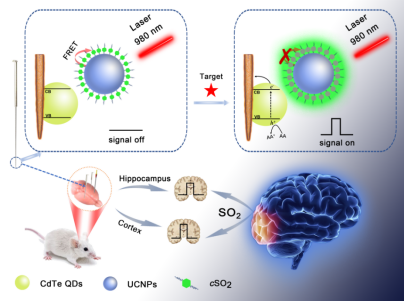Recently, the latest research result of Professor Liu Zhihong's team of School of Chemistry and Chemical Engineering, " FRET Modulated Signaling: A Versatile Strategy to Construct Photoelectrochemical Microsensors for in Vivo Analysis ", was published in Angew. Chem. Int. Ed. (DOI: German Applied Chemistry, IF: 12.959), the top journal in Chemistry. Hubei University is the first unit. Ye Xiaoxue, a postdoctoral student of the School of Chemistry and Chemical Engineering, and Wang Xing, a doctoral student of grade 2020, are the first authors. Professor Han Dongxue of Guangzhou University and Professor Liu Zhihong of Hubei University are the corresponding authors.
Microelectrode‐based electrochemical (EC) and photoelectrochemical (PEC) sensors are promising candidates for in vivo analysis of biologically important chemicals. However, limited selectivity in complicated biological systems and poor adaptability to electrochemically non‐active species restrained their applications. Herein, team of Professor Liu Zhihong proposes the concept of modulating the PEC output by a fluorescence resonance energy transfer (FRET) process. The emission of energy donor was dependent on the concentration of target SO2, which in turn served as the modulator of the photocurrent signal of the photoactive material. The employment of optical modulation circumvented the problem of selectivity, and the as‐fabricated PEC microelectrode showed good stability and reproducibility in vivo. It was able to monitor fluctuations of SO2 levels in brains of rat models of cerebral ischemia‐reperfusion and febrile seizure. More significantly, such a FRET modulated signaling strategy can be extended to diverse analytes.

Sketch Map for Principle of FRET Modulated Signaling and Application of in Vivo Analysis
The team led by Professor Liu Zhihong completed the construction of laboratory infrastructure in June 2019 and the installation and debugging of first stage instrument platform in August 2019. Besides, they did a series of distinctive work on the innovation of technologies in fluorescence, photothermal, photoacoustic and optical or electrical analysis and biological application. So far, Hubei University has published 20 papers as corresponding unit, including J. Am. Chem. Soc. (1, IF: 14.612),Angew. Chem. Int. Ed. (1, IF:12.959),Adv. Funct. Mater. (2,IF: 16.836),Small (2,IF:11.459),Trands Anal. Chem. (1, IF: 9.801),Anal. Chem. (4,IF:6.785 ),ACS Appl. Mater. Inter. (1, IF: 8.758),Biosens. Bioelectron. (1, IF:10.257),ACS Sens. (1,IF:7.333 ),Chem. Commun. (1, IF: 5.996).